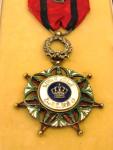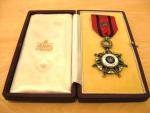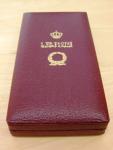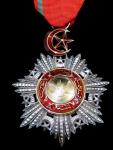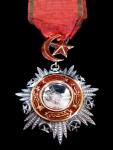-
Posts
851 -
Joined
-
Last visited
-
Days Won
3
Content Type
Profiles
Forums
Blogs
Gallery
Events
Store
Everything posted by drclaw
-

A cry for help to Thai collectors - Ratana varabhorn order
drclaw replied to khorgor's topic in South East & East Asia
A beautiful Order and, it would appear, a rare one. I've gone through my usual list of 15 or so dealers. Plenty of Crowns and Elephants but no Ratana Varabhorns. Will keep my eye out for it. Gavin -

A cry for help to Thai collectors - Ratana varabhorn order
drclaw replied to khorgor's topic in South East & East Asia
Hi Khorgor, could you post a pic of the order? That way if I or others come across it whilst window shopping at dealers' websites we can let you know? Gavin -

Egypt, Khedivate - Judge's Badge of Office
drclaw replied to drclaw's topic in Middle East & Arab States
Not at all Owain. This information is extremely helpful in expanding one's knolwedge on the history and background of these very beautiful orders. And it's not readily available information either - until your book(s) come out. ;) -

Egypt, Khedivate - Judge's Badge of Office
drclaw replied to drclaw's topic in Middle East & Arab States
Thanks Paul for clarifying that and for the Tammann catalogue which has been incredibly useful. Absolutely fascinating that a badge founded during the Khedivate, and incorporating official Ottoman elements such as the Sultan's Tughra, would continue to be issued right until the Republic. But why change such an elegant design! Gavin -

Egypt, Khedivate - Judge's Badge of Office
drclaw replied to drclaw's topic in Middle East & Arab States
Thanks gents. I'm a little nervous that it doesn't have any manufacturer's mark on the reverse, unlike the 2008 UBS example. But it weighs an absolute tonne and was heavily patinated. And I suspect there are other things one could more profitably reproduce than an obscure Egyptian badge ... -
Gentlemen, this is an Egypt, Khedivate Badge of Office of the Judges of the International Tribunal for the Legal Administration of Egypt and the Suez Canal Zone in Alexandria, just arrived from Jorg at Sammler-Cabinett. This Badge was instituted by the Khedive of Egypt, Abbas II Hilmi Bey, the last Khedive of Egypt and the Sudan. Emile Froment-Meurice, the most famous jeweler in Paris at the time and active until 1913, was commissioned to design the Badge. Imposing and of impressive size in heavy gilded silver, the Badge reflects contemporary design and the reputation of the jeweller. Egypt was at the time under the suzerainty of the Ottoman Empire and did not have its own system of Orders. This Badge could therefore be regarded as the antecedent of the later Egyptian Order system. The small circular 'medallion' at the bottom of the badge bears the Ottoman Tughra and resembles the Order of Medjidie. The Khedivate was abolished by Britain in 1914, after Turkey joined the war on the side of the Central Powers. A new Sultanate was proclaimed under Hussein Kamel, uncle of the former Khedive. Abbas II, who was hostile to Britain and supported the Central Powers, was exiled to Switzerland. An example offered for sale in the 2008 UBS Basle Auction 80 (Collection Tammann) bore the manufacturing mark of Froment-Meurice of Paris, with the original case. This example, also in heavy gilded silver, does not bear a manufacturing mark. Reference: UBS Auction 80 (Tammann Collection, November 2008)
-
Congratulations Owain, it's a beautiful set and at a reasonable price. :beer:
-
A lovely bar, Signalcorps! I'm only a recent collector of the Order of Medjidie and find the history fascinating. Many of the Medjidies were awarded to British servicemen in the 19th Century when Britain was an ally for almost 50 years. They often turn up in Crimea or Sudan medal sets. And then in WWI, it was Britain who was the enemy so you now find them in German bars. An example of how politics can change.
-

Serbia Serbia - Order of St Sava, 4th Class
drclaw replied to drclaw's topic in Southern European & Balkan States
Thanks for this Tom. I contacted his grand daughter, Petal DeVries, on both Facebook and email but did not receive a reply. The details she provided were from a website in 2007 and might no longer current. And her Facebook account might be inactive. I consulted my copy of Peter Duckers, 'European Orders and Decorations to 1945', which notes that the Order of St Sava was awarded for art, science, literature, religion or social work. The Order of Karageorge Star was awarded for military or civil service. The Order of Takova was primarily an award for military merit. And the Order of the Crown was awarded for civil and military merit. So it might be suggested that a St Sava would not have been awarded to French war veterans in the same way that the Karageorge, Takova or Crown might have. That said, it's possible that he might have been awarding it to French civilians. Duckers also notes that some of Serbia's Orders - the Orders of Karageorge, White Eagle and St Sava - remained in use in Yugoslavia 'in its early years'. Whether this extended to the late 1930s when Bojidar was Minister in Paris, is unclear. However, he also states that the St Sava (and the Yugoslav Crown) continued to be awarded by the King Peter II in exile up to his death in 1970. Tomislav Muhic and Pavel Car's book on 'Decorations and Badges of Serbia and Yugoslavia 1858-1941', might shed some more light on the awarding of these orders. Will try to pick up a copy. I can't help but be very surprised that Pouritch did not receive a single Serbian / Yugoslav order in his professional career given his position as a senior member of the Yugoslav government and senior diplomatic representative. Having the national order of the country you were representing was, in those days, almost as much a part of your uniform as a business card I would have thought, particularly if you were a very senior diplomat. Perhaps the embassy files might not be entirely complete? Was hoping that the grand daughter might shed some light about her grand father so it's a shame that I haven't been able to make contact. Was also hoping there might be a photograph of him in full dress with honours floating around somewhere. No photos of him on the League of Nations website unfortunately. Certainly a fascinating mystery but I've exhausted all my leads at my end and all I can do is offer speculative theories and hypotheses. I suspect the answer to the mystery, if it is to be found, lies in a dusty folder in Belgrade. But with war, revolution, the passage of time, and Bojidar's position as a member of the deposed and exiled regime, even that might be doubtful. Gavin -
A better analogy might be the restored and running vintage tanks at the Bovington Tank Museum. Who would have thought that something so shiny could be so deadly. :lol:
-
Cheers gents, and I forgot to mention it was Markus who spotted this one for me! :beer:
-
Hi Markus and Lorenzo, After turning deep green with envy at your collections, I can finally add some pics of my Kingdom El Rafidain. A Civil Division, 5th Class Knight(?) This just arrived from Jorg at Sammler-Cabinett. There's a slight fading of the gold inscription on the medal, which Markus mentioned earlier as fairly common with Garrard orders. Other than that, I have to agree about the exceptional craftsmanship of these beauties. Gavin
-
It's been a little quiet here so thought I'd post my Orders of Medjidie. 1) 4th (?) Class - recently purchased from Barbara Radman. It has a gold centre medallion but no rosette on the ribbon. It has a Turkish mint mark on the reverse. 2) 5th Class Crimean period - purchased from Michael at Rarusnet. I'd earlier posted pics of the Crimean Medjidie but this photo shows it after it's been carefully cleaned with a silver polishing cloth. It was sad to remove 150 years of patina (and history) but the medal has now been "restored" to as close a condition as when it first left the Istanbul mint. But I can understand how many collectors would prefer preserving the original patina of a medal. Gavin
-
Gorgeous! That Madonna is exquisite. The Spanish and Portuguese orders would have to rank among the very best in terms of their craftsmanship. I followed the link from your earlier post of the Order of Isabella to the jeweler who is still crafting the Spanish orders. Fantastic that these arts are still alive and flourishing. Gavin
-
VERY nice Markus! Congratulations on your purchase. I've been eyeing the Star of Africa for awhile now. Interesting to hear they are rarely if ever awarded now and my well be obsolete. Any thoughts on where these would have been made? Gavin
-
Thanks for sharing Emmanuel, this is most interesting! The French influence is still strong in some of the designs. That early National Order is probably the first and probably last time you will see a fully scupted Elephant's rear in any award. Gavin
-

Mini Medal Group
drclaw replied to lambert's topic in Great Britain: Orders, Gallantry, Campaign Medals
Beautiful! They are in pristine condition. I couldn't help noticing the very interesting case holding the medals. Is there a story behind the case too? Did it come with the group? Gavin -

Serbia Serbia - Order of St Sava, 4th Class
drclaw replied to drclaw's topic in Southern European & Balkan States
Thanks for this Tom. It sure is looking more and more mysterious. One thing I'm a little confused about is the second non-ebay sale comprising the Yugoslav Crown Commanders' Cross. Did the description say Pouritch was presenting a Yugoslav Crown Commanders' to the disabled veterans, or that Pouritch was presenting a St Sava Commanders? If the former, than there is no evidence that he was also presenting St Sava Commanders, or that the French ebay St Sava was presented by Pouritch. Unless of course the calling card between French ebay St Sava and the Yugoslav Crown was the same (same creases, etc). If so, this would suggest they were swapped between the two items. Gavin -
Absolutely beautiful! It's RARE ENOUGH to come across a Kretley Lion and Sun. A Boullanger ........ :jumping:
-
Thanks Emmanuel! I've always been fascinated by the comic-tragedy that was Emperor Bokassa the First (and last) ever since reading about his exploits in one of those '100 Greatest Dictators of All Time' books. Those 18 breast stars are wearing him down. He is almost crouching bow-legged in the photo next to Idi Amin! Gavin
-
Gorgeous, Markus! These French made Lions and Sun are simply superb. And the enamels on the rays are all intact. You really get a sense of regal strength in the enamel painted lions in a way that the more cartoonish Persian made Lions do not. I really must get me one of these Kretly Lions.
-

Serbia Serbia - Order of the White eagle with Swords
drclaw replied to balkanphila's topic in Southern European & Balkan States
Thanks for posting the photo TeaRex. And you're right, what an interesting photo! First, you're drawn to the row of medals on the guy's chest and the Legion of Honour and what looks like a Czech Order of the Lion next to the St Sava. Then .... the moustache .... -

Serbia Serbia - Order of St Sava, 4th Class
drclaw replied to drclaw's topic in Southern European & Balkan States
Thanks Tom, that's much appreciated. I'll let you know how my contact with the grand daughter goes. I have both a Facebook and an email address. Would be particularly interested to learn of the life after his move to the United States. The only information I have managed to glean from the interent are his US Social Security death records. It would appear that he and his wife lived a long (and hopefully happy) life together before both passing away in Illinois. 1. Bojidar POURITCH - U.S. Social Security Death Index Birth: 19 Feb 1891 State Where Number was Issued: Illinois Death: Oct 1977 2. Dara POURITCH - U.S. Social Security Death Index Birth: 4 Apr 1896 State Where Number was Issued: Illinois Death: Jan 1981 3. Douchan POURITCH - U.S. Social Security Death Index Birth: 4 Jan 1929 State Where Number was Issued: New York Death: 28 Feb 1998 All the best and will be in touch again. Gavin



